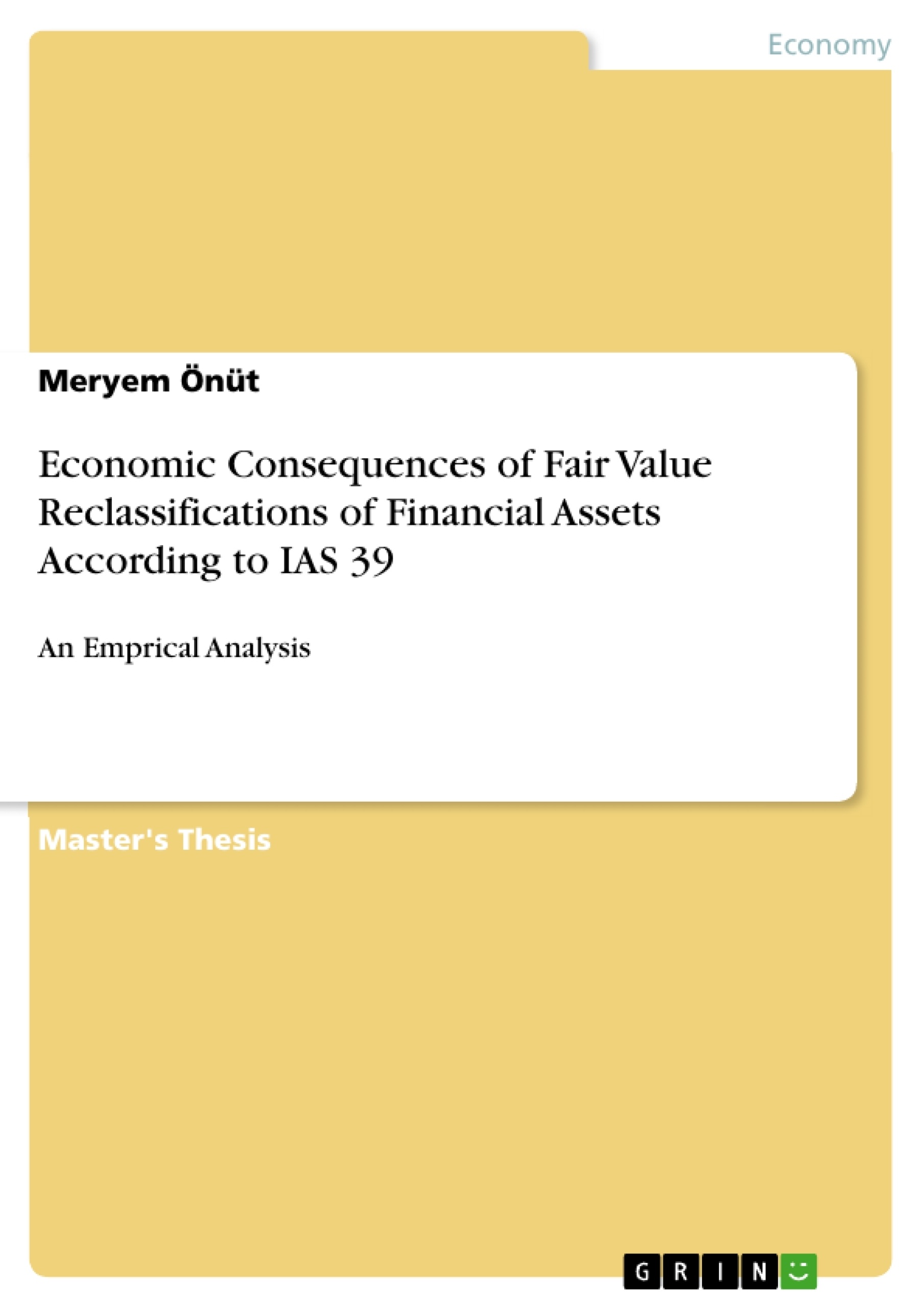The purpose of this thesis is to provide direct empirical evidence on the use of the Amendment according to IAS 39 regarding the reclassification of financial instruments. It therefore reviews what happened when the accounting policies were switched from fair value accounting to historical accounting during the financial crisis in 2008. Using a sample of manually collected data from Western European banks, the thesis empiri-cally examines which banks used this reclassification option to deal with problematic financial assets and how these reclassification activities are correlated with other firm characteristics. Furthermore, the thesis shows the influence of the amount of assets in each fair value level on the fair value hierarchy and the impact of the banks’ regulatory capital during the height of the financial crises on the use of the relaxation option. The final aim is to analyze the economic consequences of this option and to determine how beneficial it is for the global financial system, considering that banks will again make use of this sort of permission in other, future crises.
After the development of the International Financial Reporting Standards (IFRS) by the International Accounting Standard Board (IASB) in 2001, the European Union (EU) decided to unify the jurisdictions for all listed corporations and therefore decreed a mandatory adoption of IFRS in the EU. The EU reasoned that common ac-counting standards improve capital market efficiency and reduce information processing and auditing costs. However, the decisive reason for the adoption of IFRS was that today’s global economy requires global standards to ensure transparency, accountability and comparability of financial accounts. IFRS was preferred because of its focus on a fair value-based method of accounting compared to historical cost accounting, and the EU claimed that adopting IFRS would bring financial stability while serving the interests of the public.
Inhaltsverzeichnis (Table of Contents)
- Introduction
- Theoretical Framework
- IAS 39 - Financial Instruments: Recognition and Measurement
- IAS 39 and IFRS 7 Amendments: The Reclassification Option
- Bank's Regulatory Capital
- Reclassification Consequences for Bank's Financial Statements
- Related Literature
- Fair Value Hierarchy of Financial Assets
- Data and Statistics
- Data Sources and Sample Selection
- Definition of Variables
- Sample Characteristics and Representativeness
- Testing the Theoretical Predictions
- Correlation Tests
- Causality Tests
- Theoretical background
- Logit Model
- Linear Regression
- Critical Appraisal
- Conclusion
- Appendix
- References
Zielsetzung und Themenschwerpunkte (Objectives and Key Themes)
This master's thesis explores the economic consequences of fair value reclassifications of financial assets during a financial crisis. The study focuses on the impact of the amendment according to IAS 39 on Western European banks. The primary objective is to empirically analyze the effects of this amendment on bank performance and risk.
- The impact of IAS 39 amendments on bank performance
- The relationship between fair value reclassifications and bank risk
- The role of regulatory capital in mitigating the consequences of fair value reclassifications
- The effects of the financial crisis on the application of fair value accounting principles
- The implications of the findings for bank management and regulation
Zusammenfassung der Kapitel (Chapter Summaries)
- Introduction: This chapter provides an overview of the research topic and its significance. It outlines the motivations for the study, the research questions, and the structure of the thesis.
- Theoretical Framework: This chapter presents the theoretical background for the study. It discusses the relevant accounting standards, including IAS 39 and IFRS 7 amendments, and explores the implications of fair value accounting for banks. The chapter also delves into the concept of bank regulatory capital and its role in mitigating risks.
- Data and Statistics: This chapter describes the data sources and sample selection used in the empirical analysis. It defines the variables used in the study, analyzes the sample characteristics, and explains the methodology for testing the theoretical predictions. The chapter covers both correlation and causality tests, including Logit and Linear Regression models.
- Critical Appraisal: This chapter critically appraises the findings of the empirical analysis. It discusses the limitations of the study, considers alternative interpretations of the results, and provides insights into the implications of the findings.
Schlüsselwörter (Keywords)
The primary focus of this thesis revolves around the impact of fair value reclassifications on Western European banks during a financial crisis. Key concepts include IAS 39, IFRS 7 amendments, bank performance, bank risk, regulatory capital, fair value accounting, and empirical analysis. The study utilizes statistical methods such as correlation tests, Logit models, and Linear Regression to investigate the relationship between these factors.
- Quote paper
- Meryem Önüt (Author), 2015, Economic Consequences of Fair Value Reclassifications of Financial Assets According to IAS 39, Munich, GRIN Verlag, https://www.grin.com/document/376869



